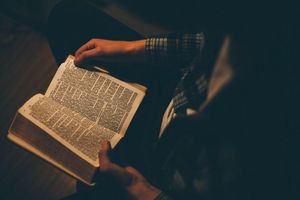The parish of Cambuslang lies five miles to the south-east of Glasgow, just south of the River Clyde. Today it is a district typical of the central belt of Scotland. It lies in the shadow of the great Ravenscraig steel mill, and as a result its economy and society were depressed by the decline of Scotland’s traditional heavy industries. Spiritually too the area is depressed, with the decayed and empty churches that are all too typical of the densely populated west of Scotland.
An historian of the Cambuslang district in the early eighteenth century described its past tranquility and its potential for development as follows: ‘Cambuslang … lieth upon the south-west side of the river Clyde… It is a pleasant and fertile soil, with good salmon fishing … the land of Greenlees … where there is coal considerable’.
The Clyde was easily fordable at Cambuslang, and many were able to cross the river on foot to reach the parish church. At that time there were about 200 families residing in the parish, comprising less than a thousand people. Most of them earned their living from farming or weaving, and a few were colliers. Its parish minister wrote, ‘from the hill of Dichmont there is one of the finest inland prospects in Scotland’. However our interest in this parish is not aroused by its pre-industrial idyllic state, but by the mighty awakening that took place there in 1742. Let us consider some of the people who were drawn into this work of God.
The people
Rev. William McCulloch was the parish minister of Cambuslang from 1731-71. He was born in 1691 in Whithorn in Wigtonshire. ‘Kircudbright and Wigtonshire were the Jerusalem and Judea of the Covenant’, wrote Andrew Symson, editor of the Register of the Synod of Galloway 1664-71. McCulloch would have grown up amongst the living martyrs of the Covenanters. He was awakened under the ministry of Rev. Mr Ker of Wigton, before going on to study at the Universities of Edinburgh and Glasgow. He was a gifted scholar, especially in the study of mathematics and Hebrew. In 1725 he was named by the ministers of Glasgow Presbytery to preach the annual probationer sermon. This was a great honour and his sermon was later published, displaying his learning and piety.
McCulloch’s son, Dr Robert McCulloch, gives us some very interesting insights into the life and ministry of his father. ‘He commonly rose about five in the morning, and excepting about 2 or 3 hours, which he allowed for relaxation, he was closely employed in study till about 8 o’clock in the evening … he spent much time in secret prayer, waiting with humble patience for a favourable return’.
A friend recorded of him, ‘I never knew such a man that seemed to be more conscientious in remembering the Sabbath day to keep it holy’. However, McCulloch was not known as a popular preacher. His son acknowledged that ‘He was not a very ready speaker; though eminent for learning and piety, he was not eloquent … his manner was slow and cautious, very different from that of popular orators’. Some parishoners mockingly called him ‘The Ale-minister’ because some of his congregation would depart for the ale house at the beginning of his sermons.
Desire for revival
For all this, the parishioners of Cambuslang were drawn to the warm evangelical tone of his preaching, and to his sincerity as a man of God. As early as 1726 the parish applied to hear him preach. The principal ‘heritor’ or patron of the parish was the Duke of Hamilton, and he had his own nominee for the Kirk in Cambuslang. After a five-year stalemate, Hamilton’s nominee was settled in West Linton, and the way was left open for McCulloch to be installed as minister of Cambuslang.
McCulloch’s influence spread beyond his own parish because in December 1741 he began to publish The Weekly History, the first religious periodical in Scotland. His purpose was to let the people of Scotland know what the Lord was doing through the Great Awakening in New England and elsewhere. He wanted to whet the popular appetite for revival. Through The Weekly History he fostered a desire for revival and also an interest in foreign mission. His published works include An Account of Some Remarkable Events at Cambuslang and Sermons on Several Subjects.
George Whitefield
Rev. George Whitefield needs less of an introduction. Together with John Wesley he was the father of early Methodism. He was born in 1714 and went to Oxford to train for the ministry of the Church of England. There he was converted after reading Henry Scougal’s The Life of God in the Soul of Man, which had been lent to him by Charles Wesley.
‘At my first reading it I wondered what the author meant by saying, “that some falsely placed religion in going to church, doing hurt to no one, being constant in the duties of the closet, and now and then reaching out their hands to give alms to their poor neighbours” … Alas! thought I, if this be not true religion, what is? God soon showed me; for in reading a few lines further that “true religion was union of the soul with God and Christ formed within us”, a ray of divine light was instantaneously darted in upon my soul, and from that moment, but not till then, did I know that I must be a new creature’.
Many years later he confessed, ‘whenever I go to Oxford, I cannot help running to the spot where Jesus Christ first revealed himself to me, and gave me the new birth’. The doctrine and experience of the new birth was the driving force behind Whitefield’s ministry.
Barred from many pulpits in the Established Church, Whitefield took to the open air to preach. He first came to Scotland in 1741 at the invitation of Ralph Erskine. This first visit lasted thirteen weeks. At first he preached in Edinburgh, then went north to Perth, Crieff, Cupar, Dundee and Aberdeen. Then he preached ten times in five days in Glasgow. Whitefield wrote in his Journal. ‘It would make your heart leap for joy to be now in Edinburgh. I question if there be not upwards of 300 in this city seeking after Jesus’.
Spiritual springtime
Reports of this tour reached McCulloch who was ever hungry for news of revival. He wrote to Whitefield, ‘It is a matter of great joy and thankfulness to God, who sent you here, and gave you so much countenance, and so remarkably crown’d your labours where at Glasgow with success… I am well informed… that there are to the number of 50 persons already got notice of in and about Glasgow that can be judg’d … are savingly converted by the blessing and power of God’.
When the early months of 1742 became a spiritual springtime in the parish of Cambuslang, McCulloch knew that he needed human assistance. On 28 April 1742 he wrote again to Whitefield, ‘I believe that in less than three months past, 300 souls have been awakened … more than 200 of these, I think, are hopefully converted… We continue to have a sermon every day. I long much to see you here. Let me know by the first opportunity when you think to be with us’. This was the call that brought the great revival preacher to Cambuslang.
Labourers together
There were other men who came to visit the parish of Cambuslang during the spring and summer of 1742. Some came to preach at the communion seasons. Some came to counsel the awakened. Some came just to observe what was happening. Some came to find fault. Some came to find salvation for their own souls. The accounts of these men have proved invaluable to succeeding generations seeking to discover what the Lord did in Cambuslang in 1742. We will hear from several of them later, and their names deserve a mention.
Dr John Hamilton was minister of the Barony Church in Glasgow, who saw stirrings of revival during his own parish ministry. He was brought into contact with the Cambuslang work when some of his parishioners returned to Glasgow clearly awakened. He wrote, ‘As soon as I was informed of their condition, I made it my business to wait upon them’. His informative account attested a great work of God.
Rev. William McKnight was an Irishman who ministered in the parish of Irvine. He was a popular preacher who was noted for his piety and came to Cambuslang to investigate the reports he had heard. His account describes the impressions of the work upon his own soul.
Rev John Willison was minister of Dundee South from 1716-50. His devotional works were the most widely read in eighteenth-century Scotland. He was known as a champion of orthodoxy within the established Church of Scotland and it was his support for the revivals in Cambuslang (and later in Kilsyth) that persuaded many that they were genuine. His letter to McCulloch of 15 April 1742 was a great encouragement and a valuable source of information.
In next month’s article we shall consider the way in which God prepared his people for the awakening, and the lessons it holds for us today.














